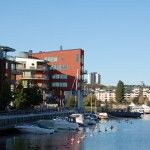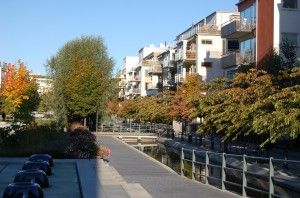We Scots draw many comparisons with our Nordic neighbours as parallels of climate and culture make these countries good reference points for our aspirations. Edinburgh, for example, was one of 10 North Sea coastal cities studied in the 2007 Waterfront Communities Project. Hammarby Sjostad is a current leading-edge example of waterfront development from which we can learn on a wide range of topics.
Stockholm is currently expanding its 1.2 million population through hitech and knowledge-based industries, directed by a strong political, academic and industrial consensus. The city was unified physically in the 1980s by bridge and tunnel projects, linking the various islands. Their 2004 Olympics bid (Athens actually won it) was the catalyst to use derelict industrial land, to create a new urban quarter.
 Hammarby is a large development of around 200 hectares and has created a new community where 26,000 people live and 10,000 work. Comparable with
Hammarby is a large development of around 200 hectares and has created a new community where 26,000 people live and 10,000 work. Comparable with
projects such as Edinburgh or Glasgow’s waterfront regeneration, it is a highly integrated mix of residential, retail, social and economic uses and has a total cost of around 4.6 billion euros.
As a place, Hammarby offers a highly attractive lifestyle. It has a waterfront setting and a great deal of care has been taken to maximize access and views of the lake and there appears to be a good mix of age groups and economic status. It is constructed of apartment buildings typically of six-storeys, organised with wide streets that provide landscaped space for play and recreation.
Although this is a high density development, every element of open space has been highly designed for people. All the apartments have balconies, all the buildings have lifts and the semi-private areas provide ample green space for bringing up families. Cars are present but they are stored communally and the high density and good public transport means their use is limited. Shops are within apartment buildings and you do not see the single storey, car surrounded supermarket, so ubiquitous in the UK. Government agencies take a similar approach and no one seems to see a problem with a primary school sharing a building with shops and apartments.
Environmental Objectives
The environmental objectives were part of the early project aspirations. In addition to compact buildings, high insulation standards and contributions from solar power, the key strategy is one of district heating. As a result heating water is delivered to all the buildings in the way we would receive gas, electricity or domestic water, creating an extremely energy efficient basic solution.
Furthermore, much of the domestic waste is used for the generation of energy. A highly impressive system is in place with three tubes (one for organic waste, one for combustible and one for newspaper) located outside each entrance. The residents place their waste in these tubes and a vacuum system then sucks the waste at 40mph to the centralised recycling depot!
Not an Eco Village
This concern with linking sustainability to lifestyle informs all parts of the project and provides a common objective that helps bind the community together. Water is metered, initiatives to encourage sustainable travel are abundant and the buses are run on bio-gas.
Interestingly, one of the initial objectives was to clearly define Hammarby as not being an “eco village”. It was specifically conceived as being a “normal” piece of city, where residents could live a normal lifestyle and where contributions to environmentalism did not require major lifestyle changes.
Of key interest to us is how this was achieved. Sweden has general political  commitment to social equality and environmentalism and a consensual approach to issues such as Planning and transport provision at a local level. The city owned much of the land and set the overall aspirations through a masterplan, while control over public transport, power and water allowed these to be easily integrated. There were 30 private sector developers involved, all of whom signed up to the overall quality aspirations and have appeared to stick to that agreement.
commitment to social equality and environmentalism and a consensual approach to issues such as Planning and transport provision at a local level. The city owned much of the land and set the overall aspirations through a masterplan, while control over public transport, power and water allowed these to be easily integrated. There were 30 private sector developers involved, all of whom signed up to the overall quality aspirations and have appeared to stick to that agreement.
Swedes spend a large proportion of their earnings on accommodation and the price of a private apartment is around £400,000. Thus the development is essentially funded through creating a high quality place that people pay to live in. There is no system of “social housing” in Sweden, the city owns accommodation for rent and systems of rent subsidy are applied.
City Making
Referring to Hammarby as “regeneration” is not strictly accurate, classifying it as “city-making” would be more appropriate. It does not attempt to revive a declining community, but builds a complete new neighbourhood, appropriate to all. In the UK, our public agencies tend to focus on improving existing neighbourhoods while our private sector creates separate new ones. Hammarby is like Scotland building a totally new piece of city, such as Morningside in Edinburgh or Woodlands in Glasgow.
Our parting thoughts on Hammarby were almost exclusively positive and it should be a standard visit for all aspiring politicians, planners and everyone else within the development and regeneration community.
ALISTAIR’S CHALLENGE FOR SCOTLAND
Can Scotland create a leading example of a new piece of city, a place people would visit to see how the best is produced? We have a number of good attempts and many current policies aim in that direction, but we need to focus on some frustratingly elusive issues in order to get up with the best.
• We need to focus on the quality of the place, rather than believing that if we set up a complex enough process, a good quality environment must surely follow.
• We need serious political champions at project level, to bring together teams of the best people and cut across the raft of conflicting organisational agendas.
• We need to have confidence in long term planning. It is the only way we can provide the infrastructure required.
• Government needs to take a more active role in city making. The private sector is vital, but the aspirations and the delivery of many of the elements are civic in nature.
My suggestion is to identify perhaps four “special waterfront projects” in the Scottish maritime cities. Assemble four different teams from public and private sectors and ask them to use the basic structure and aspirations of the Hammarby model to create four exemplary new neighbourhoods of about 5000 people. The result would give us a model for future developments and show the rest of Europe that the Scots are coming.
Any comments on this, or any other, Scotregen article are always welcome – please email andymilne@scotregen.co.uk
